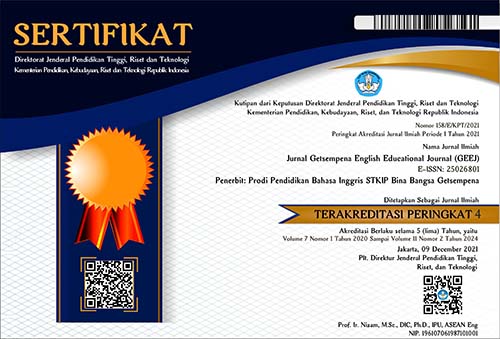ANALYSIS OF READING COMPREHENSION FINAL TEST AT ENGLISH DEPARTMENT OF MUHAMMADIYAH ACEH UNIVERSITY
Abstract
The aim of this study is not only to analyze the model and the items test set by lecturer of Reading Comprehension subject but also the ability of students according to the item questions of each final test. This study analyzes the contents taken from the document test and it used descriptive quantitative approach. The gained data derived from three Reading subjects, they are: Intensive Reading Comprehension, Reading Comprehension III dan Academic Reading. The total number of the items from those three subjects is 60 items. The findings revealed that the kind of questions asked by lecturers varied, namely; Multiple Choice, Open-ended Question, Word Matching, and True and False. Based on the those documents the writer found that 6 questions about Main Idea, 16 questions about Vocabulary, 4 about references, 6 questions about inference and 28 questions about details. Then, the results of students' reading ability in answering the items were; main idea: 63.59%, Detail: 76, 92%, Inference: 44,04, Reference ; 86, 89% and Vocabulary : 73,45 %. From the five aspects students were better to answer questions in the Reference item. The implication of this research is to provide input to examiners and lecturers in giving material and in testing students at the end of the semester and to improve the ability to make test items.
References
Abdullah, A. H., Abidin, N. L. Z., & Ali, M. (2015). Analysis of students' errors in solving Higher Order Thinking Skills (HOTS) problems for the topic of fraction. Asian Social Science, 11(21), 133.
Arikunto, S. (1990). Dasar-Dasar Evaluasi Pendidikan. Jakarta : PT Bumi Aksara.
Alderson, J. C. (2000). Assessing Reading. Cambridge; Cambridge University Press.
Bachman, L, F. (1990). Fundamental Considerations in Language Testing. Oxford: Oxford University Press.
Brown, H. D. (2004). Language Assessment: Principles and Classroom Practices. New York; Pearson Education, Inc.
Chatterji, M. (2003). Designing and Using Tools for Educational Assessment. Boston: Pearson Education, Inc.
Deacon, S. H., Tong, X., & Francis, K. (2017). The relationship of morphological analysis and morphological decoding to reading comprehension. Journal of Research in Reading, 40(1), 1-16.
Fauziati, E. (2016). Analisis Pertanyaan Pada Butir Soal Reading Comprehension Pada Test TOEIC. Universitas Muhammadiyah Surakartta. Jurnal Penelitian Humaniora, Vol. 17, No. 1, Februari 2016: 9-22.
Fitrianawati, M. (2010). Peran Analisis Butir Soal Guna Meningkatkan Kualitas Butir Soal, Belajar Peserta Didik. Seminar Nasional Pendidikan PGDS UMS & HDPGSDI Wilayah Jawa.
Heaton, J.B. (1975). Writing English Languange Tests. London : Longman Group Limited.
Hughes, Arthur. (1989, 2003). Testing for Language Teachers. 2nd ed. Cambridge: Cambridge
University Press
Karatay, H. (2017). The Effect of Literature Circles on Text Analysis and Reading Desire. International Journal of Higher Education, 6(5), 65-75.
Khoriyah. (2010). Reading I. Kediri: English Department Nusantara PGRI Kediri University Press.
Kočiský, T., Schwarz, J., Blunsom, P., Dyer, C., Hermann, K. M., Melis, G., & Grefenstette, E. (2018). The narrativeqa reading comprehension challenge. Transactions of the Association for Computational Linguistics, 6, 317-328.
Mikulecky, B. S. (2011). A short course in teaching reading: Practical technique for building reading power. United States: Pearson Longman.
Nunan, D. (2003) Nunan, David 2003. Practical English Language Teaching. New York: Mc Graw Hill.
Nurjanah, R. L. (2018). The Analysis on Students’ Difficulties in Doing Reading Comprehension Final Test. Metathesis: Journal of English Language, Literature, and Teaching, 2(2), 253-264.
Ravid, R. (2019). Practical statistics for educators. Rowman & Littlefield Publishers.
Rivers, W. M. (1968). Teaching foreign-language skills. Chicago: University of Chicago Press.
Sağirli, M. (2015). Analysis of reading comprehension levels of fifth grade students who learned to read and write with the sentence method. Journal of education and training studies, 4(2), 105-112.
Spratt, M. et al. (2005) The Teaching Knowledge Test course. Cambridge : Cambridge
University Press
Spiro, R. J., Bruce, B. C., & Brewer, W. F. (Eds.). (2017). Theoretical issues in reading comprehension: Perspectives from cognitive psychology, linguistics, artificial intelligence and education (Vol. 11). Routledge.
Weir, Cyril. (1993) Understanding and Developing Language Tests. Wilshire: Redwood Books
Wood, S. G., Moxley, J. H., Tighe, E. L., & Wagner, R. K. (2018). Does use of text-to-speech and related read-aloud tools improve reading comprehension for students with reading disabilities? A meta-analysis. Journal of learning disabilities, 51(1), 73-84.

























